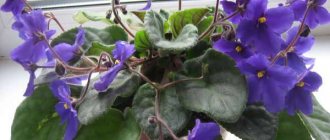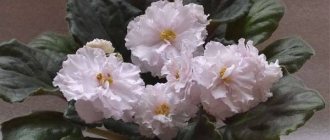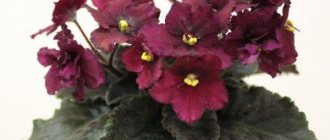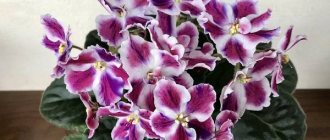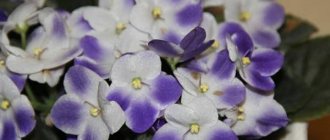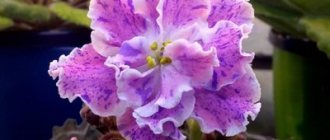Flowers often correspond to their names, and the Saintpaulias of the “Love” series fully correspond to this word . Unsurpassed and incredibly delicate flowers with beautiful leaves.
Every florist who deals with violets cannot pass by these beauties. Before adopting a new pet, it is important to familiarize yourself with the peculiarities of care and all the nuances of its growth and development. Below we will tell you about the varieties of violets AB-Lyubov, EK-Lyubov, Lyubov Orlova, Emerald Love, EK-Crazy Love: photos and descriptions, subtleties of care and maintenance.
Violet AV-Lubov (Violetkovod)
AV-Lubov is an Uzambara violet, a genus of hybrid Saintpaulia from the Gesneriev family. Bred by a breeder who goes by the pseudonym “Violet Grower” in 2013.
The flowers are large, double, reminiscent of a rose , have a corrugated edge and a green border. They are collected in several pieces on strong peduncles, which allows the bush to bloom in a cap in most cases.
The socket is quite smooth and of standard size. The leaves are large, dark green with a red underside.
The leaves are round in shape, slightly wavy along the edges with a heart-shaped base, and quite succulent. The cuttings are medium-sized, rather thick.
Features of care
AB-Lubov does not require special care , all maintenance conditions are standard for all Saintpaulias:
- lighting – bright, but without direct sunlight;
- temperature – 16-24°. In winter, it is ideal to maintain within 18°, but not drop below 14°. In summer, the maximum level is 26°, and the optimal is 24°;
Important! The green border appears well if during flowering the temperature is reduced and the rosette is moved to a more shaded place.
- watering – moderate, as needed:
- using classical methods - in a tray or under leaves. Watering frequency - once a week in the summer, and one and a half to two weeks in the winter: in the first option, water is added to the stand and after 20 minutes the excess is drained;
- in the second option, watering is carried out directly on the ground, avoiding contact with the leaves; excess water from the pan is also drained after watering.
Reviews
Alina. “At the first flowering it turned out not very frilly and without a border, I think the reason is the heat that was at that time. But I was very pleased with the shape of the flowers, pink-shaped and very decorative, they bloom like real roses - very gradually unfolding petal by petal.”
Ilya. “The flowering is simply incomparable, delicate flowers with beautiful color and shape. But my socket itself is finicky and always tries to lift the leaves up, I plan to try placing it under the lamps.”
Introduction
Violets are incredibly delicate flowers that have become real favorites of modern gardeners. They fit perfectly into the interior of a room and are able to decorate absolutely any room, no matter where the gardener plants them or displays containers with indoor Saintpaulias. Considering the demand for this plant, breeders also tried very hard to bring out the maximum number of incredibly interesting plants, varied in shape and color, that would be loved by everyone and could satisfy the needs and tastes of any modern gardener. This is how a variety of violet appeared called Peacock violet (RM-Pavlina) - this is an amazing and incredibly beautiful flower, which is characterized by expressive, abundant and very bright flowering. At the same time, the abundance of flowers and their brightness are perfectly combined with the tenderness and sensuality of the flower, with its elegance. Due to this, Saintpaulia looks great both as part of a single planting and as part of a group planting, which very often decorates window sills and balconies, office premises and, in general, any premises.
Violet EK-Love (E. Korshunova)
EK-Lyubov is a variety of Uzambara violets, bred by Elena Vasilievna Korshunova . The violet belongs to the genus Saintpaulia hybrida from the Gesneriev family.
The author herself positions this variety as an exhibition standard. The leaves are medium sized, on strong roots. The color of the leaves is deep green, round in shape with slight wavy edges.
This variety blooms ; several buds are formed on low, strong peduncles. The flowers are double and very large, the edges are strongly corrugated. The color of the flowers is a little intricate , the cherry center of the petals is framed on all sides by a white border and base.
Features of care
The care conditions for this variety have no special features and correspond to standard care for Saintpaulias :
- temperature and lighting : the light should be bright, but diffused, and the temperature should be moderate, on average 16-24° (less in winter and more in summer);
- Watering and fertilizing are carried out using two main methods: water is added to the tray (under the leaves) once a week - in the summer and a little less often in the winter. After watering, excess water is drained 20 minutes after the procedure. Fertilizers are applied periodically, approximately once every 2-3 weeks, depending on the season (through watering), and the dosage is halved;
- wick - the cord is placed in a pot and brought out through a drainage hole, a container with water is placed under the flowerpot. There is always water in the container, and fertilizers are constantly there, and its concentration decreases by 7-8 times, relative to the instructions.
Important! The amount of white on the petals depends on temperature and light, the colder and less light the smaller the cherry spot.
Reviews
Lyudmila. “The rosette is very neat, despite the fact that it is on the windowsill, it does not twist the leaves or stretch. The first bloom was average, there were few flowers, and they were not very large, and the white part was negligible. During the second flowering, I changed the growing conditions, shaded it a little and lowered the temperature, after which the very large flowers from the second bloom gave beautiful white frames.”
Ksenia. “I bought a baby EK-Lyubov, it grew very slowly, maybe my conditions are not quite right, maybe it’s just the variety that grows that way. The first flowering occurred in autumn and was sparse, the flowers were small and there were few of them. The second did not take long to happen and already in the spring I saw her in all her glory. Lush flowers with beautiful color and beautiful ruffles.”
Control
Some time after moving to a rack with LED lighting, keep an eye on the violets.
Theoretically, it could also happen that due to excessive lighting, violets will begin to hide their leaves down, trying to wrap them around the pot:
In some violets this is a varietal feature. But if all violets behave this way, then this is a sure sign that there is too much light for them. Then:
- position LED strips less frequently
- or increase the distance between the ceiling and violet leaves
- or remove the reflective foil
- …
Although in practice it is almost never possible to create a level of artificial lighting of more than 2500 lux on shelves. Only violets on a south-facing windowsill in the summer can receive excess lighting.
You are much more likely to find that under LED lighting, violets begin to pull their leaves upward due to lack of light:
Then:
- reduce the distance between shelves if the shelving design allows it
- or place suitable pieces of foam under the pots
- If that doesn’t help, then lay additional rows of LED strip.
Violet Lyubov Orlova (I. Kirillova)
Lyubov Orlova is a Saintpaulia bred by breeder I. Kirillova . Class Gesneriev, genus of hybrid Saintpaulias.
The rosette exceeds the standards in size and, under favorable conditions, grows very quickly. It maintains symmetry well , but the leaves tend to droop down. The leaves are large, fleshy, quilted, rounded with slight waviness and a slight point at the end. The leaf color is dark green.
The flowers are very large, up to 6 cm, double with a slight ruffle along the edge , the shape of the flowers is very delicate, they resemble small pink clouds. The color is pale pink, with a white border, which is very difficult to notice due to the pallor of the base color.
Powerful flower stalks rise slightly above the bush, forming a beautiful cap.
Features of care
Caring for Saintpaulia Lyubov Orlova is not very different from other varieties, but there are several nuances to prevent strong drooping of the foliage and obtain white flowers :
- Lighting - like all Saintpaulias, Lyubov Orlova prefers abundant, but diffuse. Moreover, if strong shading leads to fading of flowers, sometimes almost to white, but excessive lighting leads to more intense drooping of the leaves;
- The temperature must be maintained between 18-26°, depending on the season. A decrease in temperature leads to a strong drooping of leaves, and during the flowering period to fading and shrinking of flowers;
- Watering and fertilizing: The first method involves watering in a tray or under the leaves as needed (about once a week in summer, once every one and a half to two weeks in winter). Fertilizers are applied together with watering every other time, and the dosage is reduced by half from the recommended one;
- The second is a wick type, the water is in a container in which a string is lowered from the pot. Fertilizers are constantly in the water, in an amount of 1/7-1/8 of the recommended amount.
Reviews
Vasilisa. “I bought a leaf of this violet and was pleasantly surprised at the speed of the baby’s growth. Already at 8 months she gave me my first flowering. Even though the size of the flowers was not the maximum, I really liked them. Very delicate and neat, it turned out to be a small cap over the leaves. In the second flowering, all the flowers were 5-6 cm and the hat turned out simply amazing.”
Yana. “I bought an adult rosette with a beautiful head of flowers. When it bloomed, the leaves began to droop significantly, they actually hugged the flowerpot, I put it in a more shaded place and everything became more or less normal. Home blooms were less abundant and slightly lighter in color, but no less beautiful.”
Testing
Before assembling a large rack for LED lighting, it is recommended to select one shelf and assemble on it the LED lighting that you plan to install on the future rack. Keep a violet on the test shelf for a while and you will quickly understand:
- will this lighting be enough or not?
- determine the optimal distance between shelves
- check whether it is possible to properly care for violets when they are close to the LED ceiling or whether the distance needs to be increased
- …
A test shelf with LEDs assembled on a live string will cost much less than reworking a poorly designed rack with installed LEDs of inappropriate power.
Violet Emerald Love (Breeder E. Kolb)
Emerald Love is a violet of foreign selection , which was bred by E. Kolb, a genus of hybrid Saintpaulias from the Gesneriev family.
The rosette is slightly spreading due to the proportion of the size of the leaves relative to the length of the cuttings. The leaves are green with a clear pattern of light green veins, round in shape. Often the edges of the sheets are curled downwards.
The flowers are small, which is compensated by the abundance of flowering , with at least 5 buds formed on each peduncle. The color of the flowers is a bit like a chimera, the petals are cream in the center and the edges are light green.
Features of care
In care, Emerald Love is a completely unpretentious variety . Even under unfavorable conditions, it can grow and bloom beautifully:
- the lighting is bright but diffuse;
- temperature within 14-16°, in accordance with the season and a smooth transition into the off-season;
- watering is possible both in the classical way (in a tray or under the leaves as needed, about once a week in the summer) and wick (the wick from the pot is lowered into a container with water underneath);
- Fertilizers are carried out systematically with the first method and constantly with the wick method. The concentration in the first option is ½ and 1/7 in the second, if calculated from the recommended dosages;
- the soil yourself from peat/leaf soil/perlite/moss in the proportion 1/1/1/0.5 for the first type of irrigation and 1/0/1/0-0.3 for the second.
Important! With a lack of light and a strong drop in temperature, the leaf cuttings become elongated, and the leaves themselves stretch in the direction of the light.
Reviews
Maria. “Not a single violet has taken root with me, but Emerald Love feels great. Slightly long cuttings don’t bother me, and a bouquet of small flowers simply cannot help but please the eye.”
Firuza. “I added the Emerald Love variety to my collection. I bought a leaf and it quickly produced a beautiful baby. The first flowering was incredibly abundant. Despite the spreading nature of the bush, due to its long cuttings, I keep this variety for its flowers.”
Reviews
Igor Anatolyevich. “An amazingly beautiful variety, with a characteristic green frill along the edge, was bought at an exhibition. For several years now I’ve been pleased with the almost endless flowering.”
Marina. “Maria is very easy to care for and blooms well and profusely. The flowers look like miniature roses, only in the body of a cabbage."
The violet in question attracts flower growers with its color.
Milena. “Our new Maria has settled in wonderfully and I hope she will continue to feel good. We have another violet, Maria, who has been living and blooming for a long time, but we can’t get offspring from her - it’s a sport. I had to buy another socket, we’ll see how it multiplies.”
Violet EK-Crazy Love (E. Korshunova)
Photo of violet EK-Crazy Love.
EK-Crazy Love - Uzambara violet from Elena Vasilyevna Korshunova , bred in 2010 and belongs to the genus of hybrid Saintpaulias, the Gesneriev family.
Exhibition variety , with dark green variegated foliage, with slight wavy edges. The rosette is medium sized, smooth.
The flowers are very large, semi-double , with a wavy edge. The color is purplish-red with a dark center and small dark spots along the petals.
From 2 to 5 flowers are formed on the peduncles , and the peduncles themselves are strong and do not rise high above the bush.
Features of care
To obtain the full color of flowers, it is important to follow several rules of care , including those that differ from the classic ones:
- The lighting should be bright enough to produce dark spots on the flower, but like all Saintpaulias, it does not tolerate direct sunlight;
- The temperature is maintained within 18-24°. Severe hypothermia causes colors to fade;
- Watering can be done in the classical way (in a tray or under the leaves), but this variety responds very well to wick watering, and the flowers usually become larger;
- Fertilizers are added to the water through irrigation for the classic version, and constantly for the wick version;
- soil at home from peat/leaf soil/perlite/sphagnum moss in proportions 1/1/1/0.5 for classic irrigation and 1/0/1/0-0.3 for wick irrigation.
Advice! For those who want more variegated leaves, you will need to move the flowerpot to a more shaded area.
Reviews
Zhanna. “When I bought a leaf of this variety, I was very worried that it would take root, but rooting was successful and the baby appeared quite quickly. The first flowering appeared closer to the year, and was a little disappointing, the flowers were too small. Then I switched to wick watering and the second flowering was much more abundant and the flowers themselves were larger.”
Victoria. “I bought an adult specimen and was seduced by its incomparable color and size of flowers. She felt good at home, but the flowering at home was no longer so colorful. I had to make adjustments to the care and voila - then all the time there was only an excellent result.”
Plant propagation methods
All gardeners want to grow their own violet on their windowsill. This is quite easy to do. Violets can be grown in several ways:
- cuttings;
- stepsoning;
- propagation by seeds;
- propagation by peduncles.
Violet lovers recommend propagating the plant at home by leaf cuttings or pinching.
Advice from florists when purchasing
To make the purchased plants pleasing to the eye, listen to these tips:
- It is better to buy Saintpaulia in late spring - early summer or early autumn;
- the best place to buy is a breeders' exhibition or a specialty store;
- before purchasing, find a description of the Saintpaulia that you want to bring home, varietal characteristics, care rules;
- For purchase you can choose a cutting, a baby, a starter or a blooming adult violet.
Transplantation after purchase and during reproduction
Saintpaulias are replanted annually in the spring. The container for transplantation in the first years of life should be slightly larger than the old volume. You need to fill a third of the container with soil mixture and place the roots of the bush. Place the remaining substrate on top, leaving no empty spaces. Water the bush and place the container in a moderately lit place.
Violet Le has good immunity to diseases
Reproduction by stepson
This method is excellent for propagating the Maria violet variety. After all, it guarantees that the new plant will inherit all the maternal qualities.
- We choose a strong mother plant.
- The stepson must have more than 3 leaves.
- Carefully cut off the stepson with a sharp tool. You can use an awl or a sharp knife. At the same time, be careful not to injure the main rosette of the violet.
- For rooting, you can use a peat tablet or soil purchased in advance from the store.
- In order for the stepson to quickly take root, greenhouse conditions should be created within 1 month.
Let's get acquainted.
Vodyanoy (sports) Dadoyan
Even though it’s a sport, I love it very much!
Oksana, hello.
Oksana, hello. Your violets are beautiful, but the photo format is small. Maybe they didn't insert it according to the rules. Yes, I also like the fascinating cycle of growing violets. This is a sweet feeling of waiting for a miracle.
Oksana, welcome to
Oksana, welcome to ward No. 6! We are all obsessed with violet addiction here, just to varying degrees! Your violets are cute, and new items too! My AV-Pana Cotta and AV-Black Prince will only arrive on order in the summer.
Thank you for your hospitality.
Thank you for your hospitality. I am very pleased with the violet AB-Panacotta. She loves to bloom. It bloomed all winter, when others were resting, and now it is back with buds. Lately I've been chasing new products. In my collection, I have mostly double and semi-double violets, and I also love violets with an unusual flower shape. There are also non-terry ones (gifts for orders) but they are not particularly impressive. Exception Cinderella's dream (Deikun) - I love it and that's it!
Oksana, welcome to
Oksana, welcome to our company. I also like the growing process itself, and when it is crowned with a blooming result, it’s generally a holiday.
Oksana, Hello! Welcome! Nice violets, LE. I like Olga too, I’m thinking about buying it.
Violet Rebel s Two Cents (R. Bann)
The author who created an indescribably charming variety with a neat variegated rosette and delicately airy caps of lace corollas of a pink palette is the American breeder from Minnesota, Ruth Bann, quite well known in the world community of violet growers.
All varieties of Saintpaulia by this master are included in her personal line with the prefix Rebel’s , which invariably accompanies the name of each variety.
The variegated violet, capable of becoming a prominent centerpiece of many home collections due to its charming appearance, was introduced to flower growers in 2005.
Photo and description of the variety
The gorgeous variegated violet deservedly represents the category of classic Saintpaulia varieties , since its specimens are quite widespread in private collections.
If all the necessary agricultural techniques are followed, the violet, after the final completion of the maturation phase and the slow strengthening of the plant in the form of an adult specimen, can look like a fairly optimal in size, reasonably precise and neatly arranged bush with a neat tiled arrangement of leaf plates and a symmetrically flat configuration of shapes.
According to the author’s description, officially included in the world registers of violet growing, it is planned for Saintpaulia to maintain a gradient of the level of standard scales.
The variety, according to the observations of most gardeners, almost always develops rosettes corresponding to the description, which do not tend to increase their size beyond the boundaries of the intended format.
ATTENTION! The variety rather slowly acquires the silhouette desired by every grower.
An important feature of the growth of varietal violets is its calm and simple character : the exhibition-type rosette is formed independently, and in case of minor discrepancies in agrotechnical conditions with the needs of the plant, Saintpaulia does not show whims .
But the variety has a slight disadvantage in decorativeness - the lower leaf plates are too fond of bending towards the flowerpot.
In a medium-sized violet, the leaves are distinguished by the textural quilting of the shiny-glossy layer, the design of elongated oval “hearts” with a clearly noticeable highlight of the sharply shaped end and the graphically pressed pattern of emerald venation, which attracts attention with a clear structural pattern.
The edges of the wavy leaves can bend in any direction and are framed with sculptural, finely rounded teeth, emphasizing the openwork texture of the entire bush. The texture of the plates is unusually soft . Quite often they are observed bending towards the flowerpot.
INTERESTING! The color of the leaves of varietal violet bushes is consistent in calm variations of the green palette, but specimens with a darker color are quite often found.
The contours of the leaf plates are chicly decorated with white lace with cream reflections of various variations and widths, the tonality of which, as it moves towards the core of the rosette, can acquire a pinkish sheen.
The variegated foliage of violets has remarkable resistance to heat.
The reverse side of the leaves has a light green color, emphasized by a pinkish color at the tips.
Regular flowering of variegated violet manifests itself in the form of a gradual increase in the rapid development of ethereal-airy caps of flowers with a weakly frilled mass of petals in the corollas.
The varietal Saintpaulia is characterized by a fairly long process of blooming of semi-double and double flowers , allocated to the “star” segment, as well as by the waviness of the texture of the corollas and the artistic variability of their color within the boundaries of the pink color scheme.
Remarkably large-sized cupped corollas have wavy petals framed by a fringed frilly edge, which as a result creates a feeling of dense filling of flower caps and increases the visual perception of their volumes.
NOTABLE! During the flowering phase, the violet exhibits an interesting pattern, since the intense “eye” that lights up when the bud opens gradually loses the brightness of its color after the flower has completely dissolved.
The color scheme of the variety's corollas is based on a combination of various variations of shades of the pink palette, from delicate tones to salmon reflections. The underside of the petals is painted in a lighter color.
Violet doesn't know how to play sports.
Disease prevention and pest protection
Any violation of the recommendations for the maintenance of violets poses a risk of infection by fungi and bacteria.
Overmoistening of the soil, growing in too dense soil, excessive fertilizing, cold or heat, too high humidity are factors contributing to the development of diseases:
- late blight;
- fusarium;
- gray rot;
- rust;
- powdery mildew.
White or gray coating, brown or red spots on the leaves, lethargy and drying of the shoots indicate that the violet is affected by the disease. At the first signs, it is necessary to begin treating the plant with an appropriate fungicide. All affected leaves and shoots must be cut off, otherwise fungi and bacteria will attack healthy parts of the plant. The violet must be planted in a new pot, completely replacing the soil. Peduncles also need to be cut off.
[adsp-pro-6]
Numerous pests cause great harm to violets:
- If spots appear on the violet leaves, it is treated with a fungicide.
Scale insects - deform the leaves and leave reddish or brown spots at the bite sites. They are destroyed by the drugs Aktara, Actellik.
- Thrips - settle in flowers and destroy stamens and anthers. It is recommended to combat them with the drugs Dantol, Agravertin, Akarin.
- Aphids - cause the death of young shoots, as they mainly settle on growth points. The violet needs to be sprayed with a solution of laundry soap and tobacco infusion. If there are a lot of insects, it is recommended to use insecticides.
- Ticks: red, spider, cyclamen. Their appearance is indicated by white cobwebs and yellow spots on the leaves. The leaves begin to dry out and become deformed. Ticks are destroyed using the drugs Alatar, Fitoverm, Iskra.
Description of the variety
Absolutely all of her creations are very popular, not only in the CIS countries, but also far beyond their borders.
It was she who created the world's only variety, Lyon's Early Spring, whose distinctive feature is its huge snow-white flowers. Her violets have repeatedly received prizes at various exhibitions and competitions. LE-Odalisque is a Saintpaulia with soft pink flowers. The central part of the bud has a more saturated color and looks like a dark eye that draws the eye to the depth of the flower, thereby giving it a special charm. As the plant matures, its color changes: it becomes darker, almost coral.
The blossoming flowers are quite large (usually at least 6-7 cm in diameter). The petals are neat, have the same size, wavy shape with smooth transitions. The edges are openwork, fringed. This gives the flower a special splendor and decorativeness. The shape of the flower with wide open petals is called “star”.
The peduncles are long and strong, thanks to which the flower rises above the leaf rosettes, as if crowning them. The outlet itself is quite neat, smooth, round in shape. The size is 25-35 cm. The petioles are shortened and thickened, so the rosette seems dense. The leaf blades are rich, dark green, heart-shaped, slightly curved upward. The edges are decorated with a light yellow edging. The marks chaotically located on the sheet plates have the same shade.
How to propagate at home?
More often, the Panacotta violet is propagated by a cut leaf, that is, a cutting, but in some cases, when the plant grows strongly, it can be propagated by dividing the bush or detaching the children. Let's consider each of the options.
Cuttings
Violet cuttings involve carefully cutting a healthy medium-sized leaf from the mother plant and rooting it in water or soil, followed by planting it in a separate pot. It is advisable to look for a suitable cutting in the middle of the leaf rosette, choosing only a clean and even slightly shiny specimen, without the slightest signs of damage by diseases or pests.
After cutting with a sharp knife (powder the cut area with crushed charcoal), it is lowered into water and placed in a shaded place to form roots. It is advisable that the container for rooting the cuttings be made of dark glass, and inside it there should be chilled boiled water with an activated carbon tablet dissolved in it.
Find out more about leaf propagation of violets.
The stem of the leaf is immersed in liquid no more than 1 cm, and if after a few days it becomes less, you can always add more clean water. The cuttings can be replanted into the soil when the roots that emerge from the cut grow to 1 cm in length.
If you are afraid that the cut leaf will begin to rot in the water and you will lose the prepared planting material, you can try to root part of the violet directly in the soil, poured into disposable glasses with holes in the bottom. The cutting should be placed in such a container at an angle of 30–45°, for which the filled soil is lightly compacted and the leaf plate is supported with a toothpick.
To speed up the germination process, it is important to cover the glasses with a plastic bag, thereby achieving a greenhouse effect. A grown violet is transplanted to a permanent place of growth only when its new leaves reach a diameter of more than 3 cm
Dividing the bush
As it grows, the Panacotta violet forms the rudiments of new bushes, and in some cases, young rosettes even interfere with the main bush, occupying the space intended for it. In such situations, plant propagation by dividing the bush is not only justified, but also necessary, since it ensures the further development of the maternal form.
The process of propagating a flower in this way consists of:
- Carefully remove the rosette of the mother plant from the pot.
- Separating the young rosette (you can carefully break it off at the junction with the mother bush) and removing the lower long leaves.
- Replanting the removed planting material into a new substrate or container with water if the root system on the rosettes is poorly developed.
